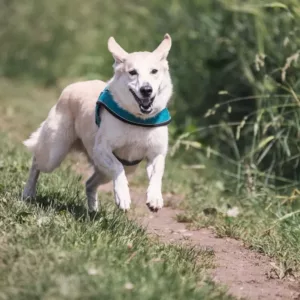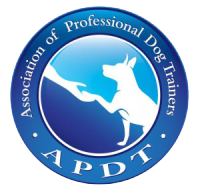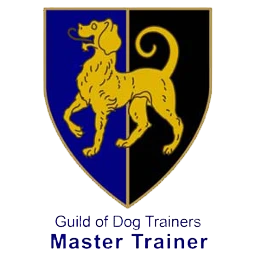 It is estimated that between a third and half of all dogs in the UK are overweight or obese. The Royal Veterinary College states: “Overweight dogs are at epidemic level in the UK, with 1 in 14 dogs are now being recorded by their vets as overweight each year.”
It is estimated that between a third and half of all dogs in the UK are overweight or obese. The Royal Veterinary College states: “Overweight dogs are at epidemic level in the UK, with 1 in 14 dogs are now being recorded by their vets as overweight each year.”
But how can you tell if your dog is overweight, what does that mean for their health and wellbeing, and what can you do to get them back into shape?
Find out more in our guide to obesity in dogs.
How To Spot Obesity Signs In Dogs
Aside from seeing it visually, many of us can turn a blind eye to our dog’s weight. Yet, canine obesity is easy to spot if you know what to look for.
From the top, your dog should have an obvious waist, tapering in from the end of the ribs, and from the side, your dog’s belly should tuck in and not hang down. When you stroke your dog, you should be able to feel their ribs and their hip bones.
If you are unsure about your dog’s weight, visit your vet. Most practices will have a set of scales in their waiting area, which you are free to use without making or paying for an appointment.
The Effects Of Obesity On Dogs
Overweight dogs will:
- Lack energy
- Be uncomfortable moving about
- Struggle to maintain a comfortable body temperature (especially in warm weather)
- Significant risk factor in several diseases.
Being overweight puts your dog at risk of heart disease, respiratory issues, musculoskeletal problems, hormonal imbalance, cancers, diabetes and many other conditions. In short, an overweight dog increases the likelihood of resulting in a sick dog, suffering illness and costing you more money at the vets. Ultimately, obesity will shorten the lifespan of your dog, which is already sadly shorter than yours.
How To Tackle Obesity In Dogs
Diet
Have a more in-depth look at what you are feeding your dog and the portion sizes and carefully assess or consult a professional for dietary advice. Too many snacks between meals or scraps from the table and oversized meal portions are the most common problems, but also the easiest to correct. You can limit their treats and measure out their food, reducing the size of their meal if they have had other snacks.
Exercise
Increasing their exercise can be a little harder, and this will take effort on your part to get them out for a walk or a run, even when it is cold and wet outside. It can be demanding, but it will also be rewarding too.
Dogs have far more enthusiasm and energy for exercise than most humans, which makes them the perfect training partner for runners. Running with your dog is more fun, and more interesting and can also offer you better protection.
Running With Dogs
A survey by the magazine, Runner’s World, found that 43% of women have been harassed while out running, rising to 58% amongst the under 30s. Even more worryingly, 30% of respondents had been followed by someone while out running, and 18% had been sexually propositioned. Taking out your dog on a run can make you feel more safe and at ease.
Not all types of dogs are right for running. Young dogs, who have yet to fully form their joints, and older dogs, who have joint issues of their own, should not go running. You’ll also find that certain breeds are better suited to running than others. Dogs with short legs may struggle to keep pace, while flat-nosed breeds (known as brachycephalic breeds) may not be able to breathe well enough for sustained exercise.
Larger dogs, such as our family protection dogs, as well as medium-sized working dogs, such as collies and springer spaniels, are ideal training partners and will match your stride, as far as you want to go.
As you get used to running together, and your dog learns the essential obedience commands, you will ultimately be able to let your dog loose, without them running away or getting distracted by other dogs or people while you run.
Dog Training
If you avoid taking them for walks because of behavioural problems, then sign up for dog training classes. When your dog is trained, they are a pleasure to walk with, and you will feel much more inclined to take them out if you know you can trust them. Fully trained dogs can also enjoy much more exercise, as you can let them off the lead, confident that they will come back to you.
We can help and support you and your dog with dog behavioural therapy and expert dog training to create the perfect fully trained dog that will live a long and happy life.
Vet Advice
As well as getting help to turn couch potatoes into fully trained dogs, you can also get help with canine weight control from your vet. They have access to special diets that can help with reducing your dog’s weight, and they can support you with professional help and advice. Many vets have special clinics for canine obesity where you can meet other owners and support each other.
Breaking Bad Habits and Dog Obesity with A&T Trained Dogs
Once your dog has got into bad habits, they can be hard to break. That’s when you need the help of the experts at A&T Trained Dogs. Our team of trainers can work with you and your dog to overcome almost any behaviour problems, either through one to one dog training courses or as part of our residential dog training courses in Lancashire. Contact us or call 01524 587315 for further information.



